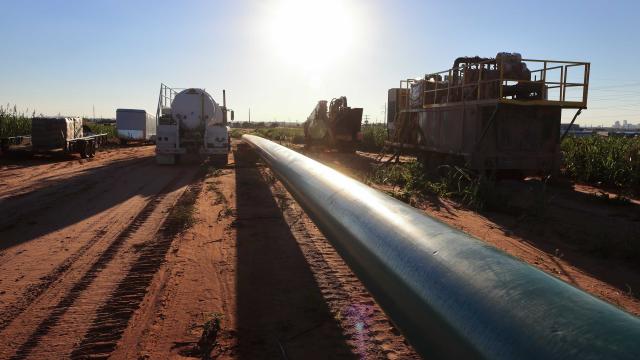
(Source: Shutterstock)
Next-day natural gas prices at the Waha hub in the Permian basin in West Texas fell below zero for the first time since early April.
Waha averaged minus 40 cents per million British thermal units (mmBtu) for May 21. The last time Waha traded below zero was April 3 when it averaged a record low minus $4.28, according to data from Refinitiv.
On the Intercontinental Exchange, meanwhile, Waha has been trading below zero all week.
Waha prices have been declining as drillers pull record amounts of oil out of the Permian, the nation’s biggest shale oil basin. Waha averaged just 92 cents/mmBtu so far this year, down from $2.10 in 2018 and a five-year average (2014-2018) of $2.80.
That oil comes out of the ground with associated gas, making the Permian the nation’s second-biggest shale gas basin.
The problem is construction of new oil and gas pipelines in the Permian has not kept up with output, which has more than doubled over the past three years as the United States has risen to become the world’s largest oil producer.
So producers are forced to burn or flare the gas, pay others with space on existing pipelines to take it or stop drilling.
They do not want to stop drilling for oil, especially with crude futures up almost 40% this year.
So they burn the gas for as long as they can—Texas rules allow firms to flare gas for up to six months—and pay other to take it when prices turn negative as they wait for new pipelines.
Permian drillers flared a record 0.4 billion cubic feet per day (Bcf/d) in third-quarter 2018 and are expected to flare at least 0.6 Bcf/d by mid-2019, according to Oslo-based energy data provider Rystad Energy.
One billion cubic feet is enough gas for about 5 million U.S. homes for a day.
Energy companies are building new pipelines, but those will not enter service until late 2019 and will likely fill up quickly, according to analysts.
Kinder Morgan Inc is working on two gas pipes—the $1.75 billion Gulf Coast Express and the $2 billion Permian Highway—that will each transport about 2 Bcf/d from the Permian to the Gulf Coast.
Gulf Coast Express is expected to enter service in fourth-quarter 2019 and Permian Highway in the second half of 2020.
Recommended Reading
Halliburton Working to Assess Cause, Impacts of Cyberattack
2024-08-22 - A Halliburton spokesperson said the company had activated a response plan and was working internally and with external experts to remediate the “issue.”
Gulfport Energy to Offer $500MM Senior Notes Due 2029
2024-09-03 - Gulfport Energy Corp. also commenced a tender offer to purchase for cash its 8.0% senior notes due 2026.
ONEOK Offers $7B in Notes to Fund EnLink, Medallion Midstream Deals
2024-09-11 - ONEOK intends to use the proceeds to fund its previously announced acquisition of Global Infrastructure Partners’ interest in midstream companies EnLink and Medallion.
Kosmos to Repay Debt with $500MM Senior Notes Offer
2024-09-11 - Kosmos Energy’s offering will be used to fund a portion of its 7.125% senior notes due 2026, 7.750% senior notes due 2027 and 7.500% senior notes due 2028.
Upstream, Midstream Dividends Declared in the Week of July 8, 2024
2024-07-11 - Here is a selection of upstream and midstream dividends declared in the week of July 8.





